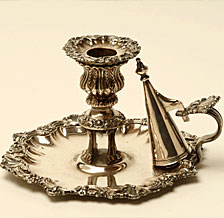

| Home | Restoration | FAQs | About Us | Customer Service |
Custom Design |
Silver Care | Silver 101 |
Silver Sales | ||||||||||


Perhaps the most misunderstood term in the antique and silver industry is "Sheffield Plate." Silver pieces described as or marked "Sheffield" can leave a false impression of origin and age. To clarify the confusion, we first define the three categories of silver involving "Sheffield". These are Sterling Silver made in Sheffield, Old Sheffield Plate, and Sheffield Plated.
In England, the word "plate" means solid silver or sterling silver; thus, silver (sterling) made in Sheffield is of high quality and bears the appropriate "hallmarks." A hallmark is a mark used in England to stamp gold and silver articles that meet established standards of purity. The marks for sterling are easily found and defined in most hallmark books.
The second category, "Old Sheffield Plate," refers to a process discovered around 1790, in which a sheet of copper is fused to a thinner sheet of sterling silver. The pieces produced, primarily hollowware, are sometimes marked. These would be made by premier Sheffield manufacturers, but, ironically, are never marked using the word "Sheffield." For example, Matthew Boulton uses two stars next to each other as his mark, Crestwicks uses a diamond shaped crossing pattern, and James Dixon & Sons uses an initial with a symbol [d*s]. This industry lasted for about 40 years. There are three ways to identify "Old Sheffield Plate."
-
Closely examine the edges of the upper rim and the base to find the seam where the metal has been folded over. Any applied border, handles, or feet will usually have a seam that indicates a layer of silver has been lapped over or "sandwiched".
-
Look for a square, round, or rectangular "shadow" around any engraved crests or initials. The shadow is the outline of a piece of solid sterling silver, which is inlaid to prevent the copper from showing through when a family crest is engraved.
-
Look at the inside of vessels and the underside of trays for a grayish coating of tin. This is the case in some of the earlier pieces. The unsightly copper on the inside of these pieces was coated with a layer of tin. The tin, usually unfinished, is distinguishable by its pewter-like color.
The third category, Sheffield Plated, refers to items made of any combination of metals, but primarily copper. These pieces are electroplated with a layer of silver. They are marked with a variety of hallmarks that sometimes resemble English sterling marks. Some manufacturers use the word Sheffield in their name or in the marking of their wares. Silver electroplated pieces made in England will naturally be stamped "Sheffield" or "Made in Sheffield." Even though the pieces are electroplated on copper, they are not "Old Sheffield Plate."
